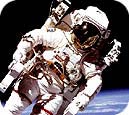One of the recurring themes in the screeds that followed the Kansas State Board of Education decision last year was that this decision revealed a much more pervasive problem: a widespread “anti-science” attitude among the American people. Oh, really? A visiting Martian would get a very different impression from the huge media coverage (magazines, newspapers, television, National Public Radio: you name it) given to the $210 million Rose Center for Earth and Space at the American Museum of Natural History in Manhattan, including the completely revamped Hayden Planetarium.
 Southern Baptists have asked their denomination-owned retail chain to stop selling a best-selling Bible translation, saying it contains errors when it comes to language about gender.
Southern Baptists have asked their denomination-owned retail chain to stop selling a best-selling Bible translation, saying it contains errors when it comes to language about gender.
Church delegates—known as messengers—passed a resolution at their June annual meeting in Phoenix criticizing the 2011 update to the New International Version (NIV) as an "inaccurate translation of God's inspired Scripture." They asked LifeWay Christian Resources not to sell the NIV 2011, which avoids using male terms in passages where context suggests that both genders are intended, except where the pronoun in question has messianic allusions.
"This is as big as it gets," said Jim Overton of Halteman Village Baptist Church in Muncie, Indiana. "This is the word of God. … As Southern Baptists, I don't think we have the luxury of not speaking to this important issue."
But the convention's resolution committee disagreed. They declined Overton's resolution when it was first submitted to them.
Committee member Russell Moore, dean of Southern Baptist Theological Seminary, told delegates that he has concerns about the new NIV but didn't think it "rose to the level of needing to be addressed by this year's convention."
Moore authored a 2002 resolution against a previous update, Today's New International Version (TNIV), which asked LifeWay not to sell that product. In that case, LifeWay's leadership decided not to sell the edition.
The TNIV was a publishing flop, in part because of opposition by groups like Focus on the Family and the Council on Biblical Manhood and Womanhood.
That opposition was part theological and part personal.
Critics felt like the Committee on Biblical Translation (CBT), which produced the NIV and TNIV, had broken a promise they'd made to James Dobson and other conservative leaders not to produce a gender-inclusive NIV.
Moore said the TNIV was a stealth project that Southern Baptists needed to oppose.
But this time, members of the CBT reached out to critics like Moore.
That didn't lead critics to embrace the new NIV. But it seems to have muted the criticism.
Doug Moo, Blanchard Professor of New Testament at Wheaton College and spokesman for the CBT, said the Southern Baptist resolution was unfair.
He said that the committee, comprising both complementarian and egalitarian scholars, followed the same translation standards as groups like Wycliffe Bible Translators. Their goal, he said, was not to appease TNIV critics but to create an accurate translation.
"That was our only agenda," he said.
Verne Kenney, executive vice president of sales at Zondervan, which publishes the NIV, said sales of the NIV 2011 have exceeded expectations. "They are up in what has been a declining trade-book market."
Zondervan and the CBT have taken a wait-and-see approach to the possibility that LifeWay would drop the latest NIV.
The Christian-retail chain currently sells both the latest NIV and the older version. LifeWay does not reveal sales numbers, but a search of LifeWay.com produced a list of more than 200 NIV products, from the "NIV Study Bible: Update Edition" to the digital "GoBible Player Complete, NIV."
"[We] will continue to sell the 2011 NIV while working through the process of review with our board of trustees," said LifeWay spokesman Micah Carter.
That delay reflects Southern Baptist policy. LifeWay's trustees—not the annual meeting—make policy decisions.
"Resolutions are statements of opinion by messengers at a particular convention," said Frank Page, president of the convention's executive committee. "They are not legally binding."
Page said that trustees shouldn't ignore the resolution. But they are free to make their own decision. He's a fan of the older edition of the NIV.
"I do wish Zondervan would continue publishing and printing the older edition, which I love dearly," he said.
That option isn't part of Zondervan's long-term plan, said Kenney. He said that the NIV was originally published in 1978, and that edition went out of print once the translation was updated in 1984. The publisher plans the same approach with the 2011 edition.
But some pew editions are still being sold during the transition period. "We're doing that as a convenience to churches."
Copyright © 2011 Christianity Today. Click for reprint information.
Related Elsewhere:
Additional coverage of gender issues and Bible translation includes:
A Liberating Woman: A Reflection on the Founder of Christians for Biblical Equality | Catherine Clark Kroeger championed women's equality without budging on scriptural authority. (July 12, 2011)
What the TNIV Means for Evangelical Women | To see it go won't mean that much, actually. (September 3, 2009)
Correcting the 'Mistakes' of TNIV and Inclusive NIV, Translators Will Revise NIV in 2011 | "We fell short of the trust that was placed in us." (September 1, 2009)
See Christianity Today's news section and liveblog for more news updates.
And what will those 4.5 million visitors—our Martian incognito among them—find when they enter this temple of science? To get an idea, check out the February issue of Natural History, the superbly produced magazine of the American Museum of Natural History. This is a special issue titled “To Know the Universe.” It features an introduction by Ellen Futter, president of the museum and the driving force behind this project, who says that “together with our beloved exhibition halls, the Rose Center will enable the Museum to take visitors on a grand and all-encompassing journey that tells a coherent, comprehensive story of life, from the outer reaches of the universe to the planet’s inner core and through the extraordinary diversity of life and culture on Earth.” Futter’s introduction is titled “A Seamless Vision.”
The issue is devoted to fleshing out those remarkable claims. Many of the contributors are prominent scientists—Allan Sandage, Margaret Geller, Alan Guth, and Brian Greene, for example—and all of them are gifted communicators. Neil de Grasse Tyson, the director of the Hayden Planetarium, contributes two essays. And among the magazine’s regular departments there is Stephen Jay Gould’s column, which picks up the issue’s special theme; his essay is titled “What Does the Dreaded ‘E’ Word Mean, Anyway? A Reverie for the Opening of the New Hayden Planetarium.”
So what is the story these pieces collectively tell? Start with a callout quote from Gould’s essay: “Many people cling to the comforting view that human consciousness must represent a predictable (if not divinely intended) summit of biological existence.” Flip a few pages over to a description of the way the new planetarium seeks to convey “the size and scale of objects in the universe.” Are you beginning to get the picture?
Here’s Edward Rothstein’s account in the New York Times (February 19):
if Copernicus and Galileo showed that humanity is not at the center of the universe, here humanity is not even at the center of the planetarium. The planetarium is not an attempt to project the human imagination outward, giving shape to the heavens, but an attempt to project that cosmos inward, imprinting it on the human imagination, stupefying it. The allusions to myth [in the old Hayden Planetarium], the city buildings at night, the view of the stars from earth’s reference point—all this has been put aside. Instead of bringing the cosmos home, the home has been thrust, untethered, into the cosmos.
I am looking forward to visiting the museum at the first opportunity. I am sure there will be much to learn, and much occasion for wonder. But I don’t expect to take from it the story that its makers seem to have intended.
Related Elsewhere
Visit Books & Culture online at BooksandCulture.com or subscribe here.
The Rose Center for Earth and Space‘s site has a virtual tour of the museum, information about the various exhibits and areas, a special Mars section, plus it makes your mouse cursor all sparkly.
The February issue of Natural History magazine has some articles online, but none of its special articles on the Rose Center are available.
Books & Culture Corner appears Mondays at ChristianityToday.com. Earlier Books & Culture Corners include:
Guelzo’s Lincoln Book a Winner | Established by Richard Gilder and Lewis Lehrman to honor the best historical work each year on Lincoln and the Civil War era, the prize is now in its tenth year. By Allen C. Guelzo. (Feb. 21, 2000)
Nancy Drew and the Wine-Dark Sea | The importance of good literature—and how to get young people to read it. By Sarah Cowie (Feb. 14, 2000)
Spring in Purgatory: Dante, Botticelli, C. S. Lewis, and a Lost Masterpiece | The most popular illustration of Dante’s “Divine Comedy” has remained effectively “lost” for 500 years—although millions have seen it and admired it. By Kathryn Lindskoog (Feb. 7, 2000)
Playwright, Dissident, Czech President … Who Is This Man? | A new biography of Václav Havel fills in important blanks, but omits his theology. By Jim Sire (Jan. 31, 2000)
An Open Letter to the U. S. Black Religious, Intellectual, and Political Leadership Regarding AIDS and the Sexual Holocaust in Africa (Jan. 24, 2000)
Tony Blair’s Devolution Revolution | Paving the way for peace in the United Kingdom. By Michael LeRoy (Jan. 17, 2000)
Loving the Alien, in Sickness and in Health | Too many recipients of health care today feel neither tolerated nor entitled, let alone loved. By Diane Komp (Jan. 10, 2000)

Copyright © 2000 Christianity Today. Click for reprint information.








